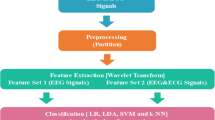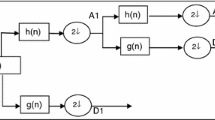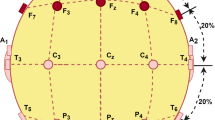Abstract
Previous research in the field of cognitive science clearly emphasizes the importance of coherence in language processing and the analysis of mental tasks. In this paper, electroencephalography (EEG)-based coherence between different pairs of electrodes has been used for the classification of mental arithmetic capability for different subjects. EEG signals were obtained using 19 electrodes when 36 subjects performed mental arithmetic operations. These EEG signals were denoised using wavelet-based techniques. Then the signals were decomposed into alpha, beta, gamma, delta, and theta frequency bands. The magnitude squared coherence in all the individual frequency bands for different pairs of electrodes was calculated. The high coherence was prevalent in the anterior frontal and frontal electrodes. It can also be seen from this work that the alpha band provides maximum coherence. The coherence features were classified in the alpha band using a non-linear support vector machine and 97.6% accuracy was achieved. To reinforce our findings, the work has been compared in a concurrent framework using statistical features such as mean, variance, and skewness. The classification accuracies were 72.3%, 61.4%, and 53.9% respectively using the above three features respectively. This study shows the effectiveness of coherence features by providing additional insights regarding the involvement of different brain areas in cognitive processes.










Similar content being viewed by others
References
Agarwal P, Kumar S (2021a) Transforming imagined thoughts into speech using a covariance-based subset selection method. Indian J Pure Appl Phys 59:180–183
Agarwal P, Kumar S (2021) Imagined word pairs recognition from non-invasive brain signals using Hilbert transform. Int J Syst Assur Eng Manag. https://doi.org/10.1007/s13198-021-01283-9
Agarwal P, Kumar S (2021) Electroencephalography based imagined alphabets classification using spatial and time-domain features. Int J Imaging Syst Technol. https://doi.org/10.1002/ima.22655
Beaumont JG, Mayes AR, Rugg MD (1978) Asymmetry in EEG alpha coherence and power: effects of task and sex. Electroencephalogr Clin Neurophysiol 45:393–401. https://doi.org/10.1016/0013-4694(78)90190-6
Bozdoğan A, Uştu M, İleri R, Latifoğlu F (2021) Detection of epilepsy using wavelet coherence and convolutional neural networks. 2021 Medical technologies congress (TIPTEKNO). Antalya, Turkey, pp 1–4
Essl M, Rappelsberger P (1998) EEG cohererence and reference signals: experimental results and mathematical explanations. Med Biol Eng Comput 36:399–406. https://doi.org/10.1007/BF02523206
Fauvet M, Cremoux S, Chalard A et al (2019) A novel method to generalize time-frequency coherence analysis between EEG or EMG signals during repetitive trials with high intra-subject variability in duration. In: 2019 9th International IEEE/EMBS Conference on Neural Engineering (NER). San Francisco, CA, USA, pp 437–440
French CC, Beaumont JG (1984) A critical review of EEG coherence studies of hemisphere function. Int J Psychophysiol 1:241–254. https://doi.org/10.1016/0167-8760(84)90044-8
Goldberger AL, Amaral LAN, Glass L et al (2000) PhysioBank, PhysioToolkit, and PhysioNet: components of a new research resource for complex physiologic signals. Circulation 101:e215–e220. https://doi.org/10.1161/01.CIR.101.23.e215
Harmony T, Fernández T, Silva J et al (1999) Do specific EEG frequencies indicate different processes during mental calculation? Neurosci Lett 266:25–28. https://doi.org/10.1016/S0304-3940(99)00244-X
Igasaki T, Yamashita K, Ushijima T (2019) Force-Temporal Characteristics of EEG-EMG Coherence during Isometric Contraction of Lateral Head of Gastrocnemius Muscle. In: 2019 41st Annual International Conference of the IEEE Engineering in Medicine and Biology Society (EMBC). Berlin, Germany, pp 2157–2160
Karaca BK, Akşahin MF, Öcal R (2019) Detection of multiple sclerosis disease by EEG coherence analysis. 2019 Medical technologies congress (TIPTEKNO). Izmir, Turkey, pp 1–4
Khan DM, Masroor K, Jailani MFM et al (2022) Development of wavelet coherence EEG as a biomarker for diagnosis of major depressive disorder. IEEE Sens J 22(5):4315–4325. https://doi.org/10.1109/JSEN.2022.3143176
Khanam A, Farooq O (2020) Coherence analysis of EEG in bidirectional reading task (BRT). In: 2020 IEEE 7th Uttar Pradesh Section International Conference on Electrical, Electronics and Computer Engineering (UPCON). Prayagraj, India, pp 1–6
Klem GH, Lüders HO, Jasper HH, Elger C (1999) The ten-twenty electrode system of the international federation. The international federation of clinical neurophysiology. Electroencephalogr Clin Neurophysiol Suppl 52:3–6. https://doi.org/10.1080/00029238.1961.11080571
Kumar S, Verma PR, Bharti M, Agarwal P (2021) A CNN based graphical user interface controlled by imagined movements. Int J Syst Assur Eng Manag. https://doi.org/10.1007/s13198-021-01096-w
Leocani L, Comi G (1999) EEG coherence in pathological conditions. J Clin Neurophysiol 16:548–555. https://doi.org/10.1097/00004691-199911000-00006
Marosi E, Harmony T, Becker J et al (1995) Electroencephalographic coherences discriminate between children with different pedagogical evaluation. Int J Psychophysiol 19:23–32. https://doi.org/10.1016/0167-8760(94)00059-N
Miller R (ed.) (2000) Coherence and phase relations between EEG traces recorded from different locations. In: Time and the brain. CRC Press, Boca Raton
Oon HN, Saidatul A, Ibrahim Z (2018) Analysis on Non-Linear Features of Electroencephalogram (EEG) Signal for Neuromarketing Application. In: 2018 International Conference on Computational Approach in Smart Systems Design and Applications (ICASSDA). Kuching, Malaysia, pp 1–8
Palaniappan R (2006) Utilizing gamma band to improve mental task based brain-computer interface design. IEEE Trans Neural Syst Rehabilitation Eng 14:299–303. https://doi.org/10.1109/TNSRE.2006.881539
Rahman MM, Chowdhury MA, Fattah SA (2018) An efficient scheme for mental task classification utilizing reflection coefficients obtained from autocorrelation function of EEG signal. Brain Inf 5:1–12. https://doi.org/10.1007/s40708-017-0073-7
Siuly S, Li Y, Zhang Y (2016) EEG signal analysis and classification: Techniques and applications, 1st edn. Springer, Cham
Tang Z, Yu H, Lu C et al (2019) Single-trial classification of different movements on one arm based on ERD/ERS and corticomuscular coherence. IEEE Access 7:128185–128197. https://doi.org/10.1109/ACCESS.2019.2940034
Weiss S, Mueller HM (2003) The contribution of EEG coherence to the investigation of language. Brain Lang 85:325–343. https://doi.org/10.1016/S0093-934X(03)00067-1
Zyma I, Tukaev S, Seleznov I et al (2019) Electroencephalograms during mental arithmetic task performance. Data 4:14. https://doi.org/10.3390/data4010014
Acknowledgments
“The study was approved by the Bioethics Commission of Educational and Scientific Centre “Institute of Biology and Medicine”, Taras Shevchenko National University of Kyiv” (Zyma et al. 2019). All procedures performed in studies involving human participants were in accordance with the ethical standards of the World Medical Association declaration of Helsinki of 1975 (Zyma et al. 2019). The dataset can be downloaded from https://physionet.org/physiobank/database/eegmat/.
Funding
The authors did not receive support from any organization for the submitted work.
Author information
Authors and Affiliations
Corresponding author
Ethics declarations
Conflict of interest
The authors have no conflicts of interest to declare that are relevant to the content of this article.
Additional information
Publisher’s Note
Springer Nature remains neutral with regard to jurisdictional claims in published maps and institutional affiliations.
Rights and permissions
Springer Nature or its licensor (e.g. a society or other partner) holds exclusive rights to this article under a publishing agreement with the author(s) or other rightsholder(s); author self-archiving of the accepted manuscript version of this article is solely governed by the terms of such publishing agreement and applicable law.
About this article
Cite this article
Kumar, S., Shekhar, S. & Agarwal, P. Cognitive capability identification in performing mental tasks using EEG-based coherence. Int J Syst Assur Eng Manag 14, 334–342 (2023). https://doi.org/10.1007/s13198-022-01799-8
Received:
Revised:
Accepted:
Published:
Issue Date:
DOI: https://doi.org/10.1007/s13198-022-01799-8




